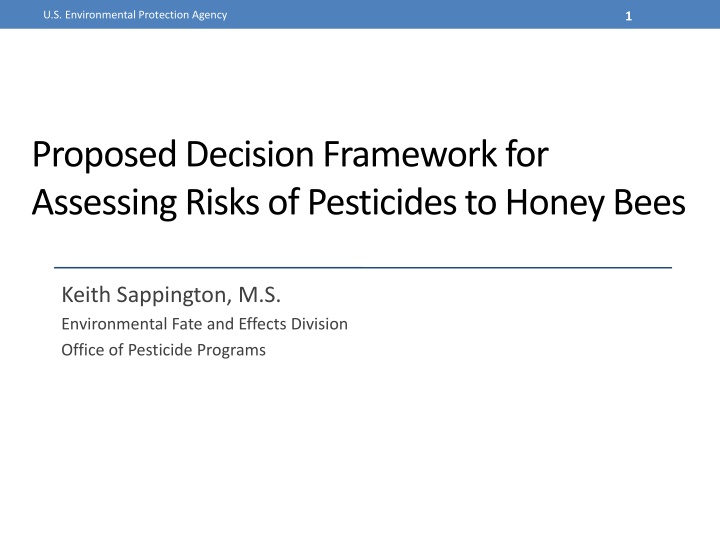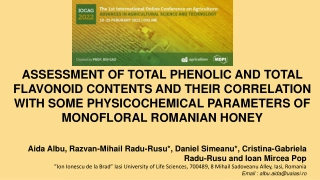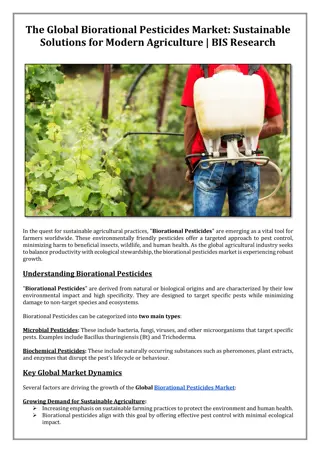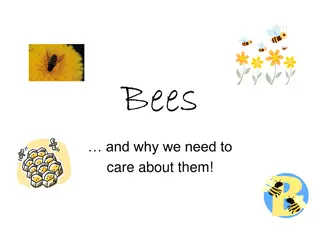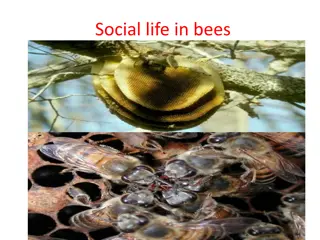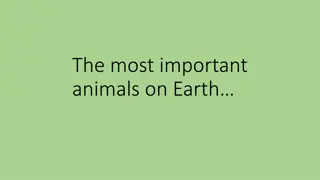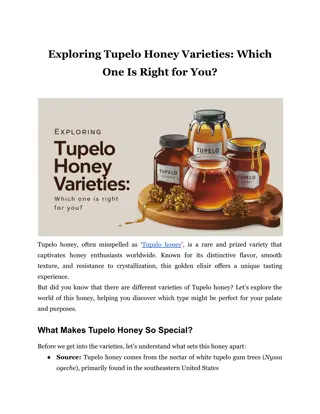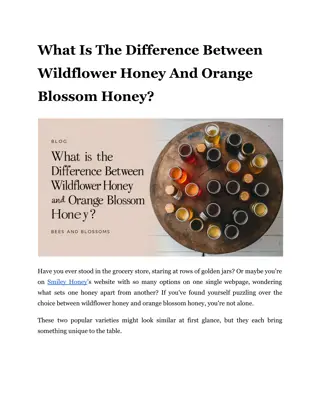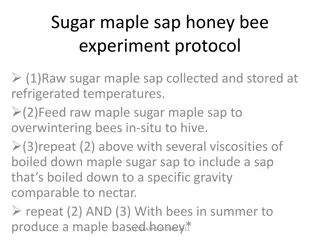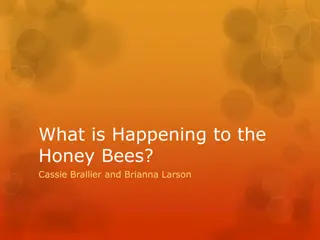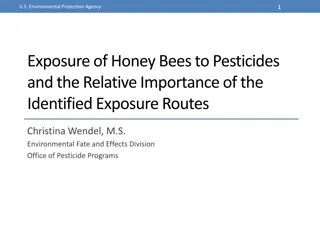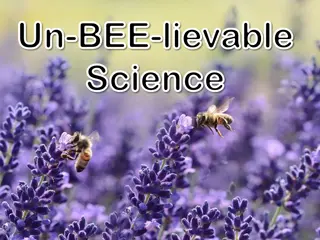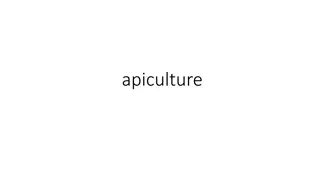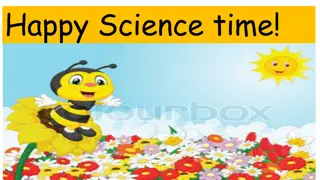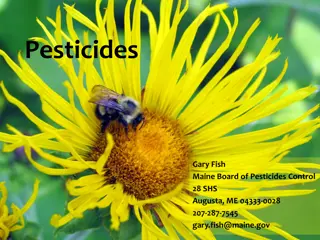Proposed Decision Framework for Assessing Risks of Pesticides to Honey Bees
The U.S. Environmental Protection Agency has outlined a comprehensive decision framework for evaluating the risks of pesticides to honey bees. The framework consists of three tiers of risk assessment, focusing on exposure pathways and effects at both individual and colony levels. The approach involves screening assessments, data integration, and considering uncertainties to make informed decisions. Tiered assessments allow for flexibility, iterative evaluations, and future improvements to ensure the protection of honey bee populations.
Download Presentation

Please find below an Image/Link to download the presentation.
The content on the website is provided AS IS for your information and personal use only. It may not be sold, licensed, or shared on other websites without obtaining consent from the author.If you encounter any issues during the download, it is possible that the publisher has removed the file from their server.
You are allowed to download the files provided on this website for personal or commercial use, subject to the condition that they are used lawfully. All files are the property of their respective owners.
The content on the website is provided AS IS for your information and personal use only. It may not be sold, licensed, or shared on other websites without obtaining consent from the author.
E N D
Presentation Transcript
U.S. Environmental Protection Agency 1 Proposed Decision Framework for Assessing Risks of Pesticides to Honey Bees Keith Sappington, M.S. Environmental Fate and Effects Division Office of Pesticide Programs
2 U.S. Environmental Protection Agency Outline Problem Formulation 1. Attributes of Proposed Process As Needed: Get Data, Iterate, Monitor Integrate Available Information Source & Ecosystem Ecological Exposure at Risk Effects 2. Process for Foliar Spray Applications Planning Assessment Endpoints Conceptual Model 3. Process for Soil/Seed Treatment Applications Analysis Plan 4. Comparison with other published risk assessment schemes Analysis
3 U.S. Environmental Protection Agency Attributes of Proposed Decision Framework Three risk assessment tiers Tier 1 = screening level assessment (conservative, quantitative, individual-level effects) Tiers 2 and 3 = increasing information needs (greater realism, refined estimates of exposure, risk characterized at colony level) Relies largely on guideline studies (and recommends several in development) Focuses on major (and quantifiable) exposure pathways of concern Separate process for foliar vs. soil/seed treatment applications Decisions consider multiple lines of evidence and uncertainty
4 U.S. Environmental Protection Agency Application of Proposed Decision Frameworks New vs. existing pesticides Iterative nature of assessments Framework flexibility Future modifications
5 U.S. Environmental Protection Agency 1. Details of the product and its use pattern Presumption of minimal risk No Tier 1 brood assessment 2a. Is exposure of adult bees a concern? 2b. Is exposure of bee brood a concern? Oral Exposure Contact Exposure Oral Exposure 3a. Calculate Tier 1 screening-level EEC for adult contact exposure 3c. Calculate Tier 1 screening-level EEC for larval oral exposure via brood food 3b. Calculate Tier 1 screening-level EEC for adult oral exposure via pollen and nectar 4a. Calculate Tier 1 screening-level RQs for adult contact exposure (RQ = EEC/adult acute contact LD50) 4b. Calculate Tier 1 screening-level RQs for adult oral exposure (RQ = EEC/adult acute oral LD50 & RQ = EEC/adult chronic NOAEC)* 4c. Calculate Tier 1 screening-level RQs for larval oral exposure (RQ = EEC/larval acute LD50 & RQ= EEC/larval chronic NOAEC)* Tier 1 Risk Assessment Scheme for Foliar Spray Application 5 a,b,c. Does any RQ exceed LOC? 6. Refine Tier 1 Exposure Assessment (e.g., using available crop residue studies), Recalculate RQs. Presumption of minimal risk 7 a,b,c. Does any RQ exceed LOC? 9a. Conduct Tier 2 Exposure Studies (e..g, residues in pollen, nectar) 8. Consider Risk Mitigation Options, Uncertainties, Other lines of Evidence; Is a higher tier assessment needed? 9b. Conduct Tier 2 Colony- Level Effect Studies (e..g, semi-field, feeding) Tier 2 10. Evaluate Tier 2 exposure and colony-level effect results. Consider uncertainties and other lines of evidence. Do results indicate risk? 11. Consider Risk Mitigation Options, Uncertainties, Other Lines of Evidence; Is a higher Tier assessment needed? 12. Conduct Tier 3 Field Studies to address uncertainties Presumption of minimal risk Tier 3 13. Evaluate Tier 3 field study results. Consider risk mitigation options, uncertainties and other lines of evidence. Do results indicate risk? Y N Presumption of risk * When tests are sufficiently developed and vetted Optional
6 U.S. Environmental Protection Agency 1. Details of the product and its use pattern Presumption of minimal risk No Tier 1 brood assessment 2a. Is exposure of adult bees a concern? * 2b. Is exposure of bee brood a concern? * Oral Exposure Oral Exposure 3a. Calculate Tier 1 screening-level EEC for adult oral exposure via pollen and nectar 3b. Calculate Tier 1 screening-level EEC for larval oral exposure via processed brood food Risk Assessment Scheme for Soil/ Seed Treatment Application 4a. Calculate Tier 1 screening-level RQs for adult oral exposure (RQ = EEC/adult acute oral LD50& RQ =EEC/chronic adult NOAEC)** 4b. Calculate Tier 1 screening-level RQs for larval oral exposure (RQ = EEC/larval acute LD50& RQ= EEC/chronic larval NOAEC)** 5 a,b. Does any RQ exceed LOC? 6. Refine Tier 1 Exposure Assessment (e.g., using available crop residue studies), Recalculate RQs. Presumption of minimal risk* 7 a,b,c. Does any RQ exceed LOC? 8. Consider Risk Mitigation Options, Other Lines of Evidence and Uncertainties; Is a higher tier assessment needed? 9a. Conduct Tier 2 Exposure Studies (e..g, residues in pollen, nectar) 9b. Conduct Tier 2 Colony- Level Effect Studies (e..g, semi-field, feeding) 10. Evaluate Tier 2 exposure and colony-level effect results. Consider uncertainties and other lines of evidence. Do results indicate risk? 12. Conduct Tier 3 Field Studies to address uncertainties 11. Consider Risk Mitigation Options, Other Lines of Evidence and Uncertainties; Is a higher tier assessment needed? Presumption of minimal risk 13. Evaluate Tier 3 field study results. Consider risk mitigation options, uncertainties and other lines of evidence. Do results indicate risk? Y N *Mitigation of risks from abraded seed coatings is addressed outside of this process ** When tests are sufficiently developed Optional Presumption of risk
7 U.S. Environmental Protection Agency Comparison to Other Risk Assessment Schemes European Food Safety Authority (EFSA 2012) Society of Environmental Toxicology and Chemistry Pellston Workshop (Fischer and Moriarty 2011) Some Similarities: All involved tiered processes (effects at the individual level, then at the colony level) Different schemes depending on application method (foliar spray, soil, seed treatment) Contact and oral are dominant routes of exposure All recognize need for acute and chronic effects to be assessed initially Some Differences: Decision triggers take various forms (when specified) Non-Apis bees are included in EFSA (2012) and Fischer and Moriarty (2011), although full implementation will require additional research and test development. Risk conclusions at higher tiers consider multiple lines of evidence, (White Paper); other schemes rely on outcome of semi field or field studies
